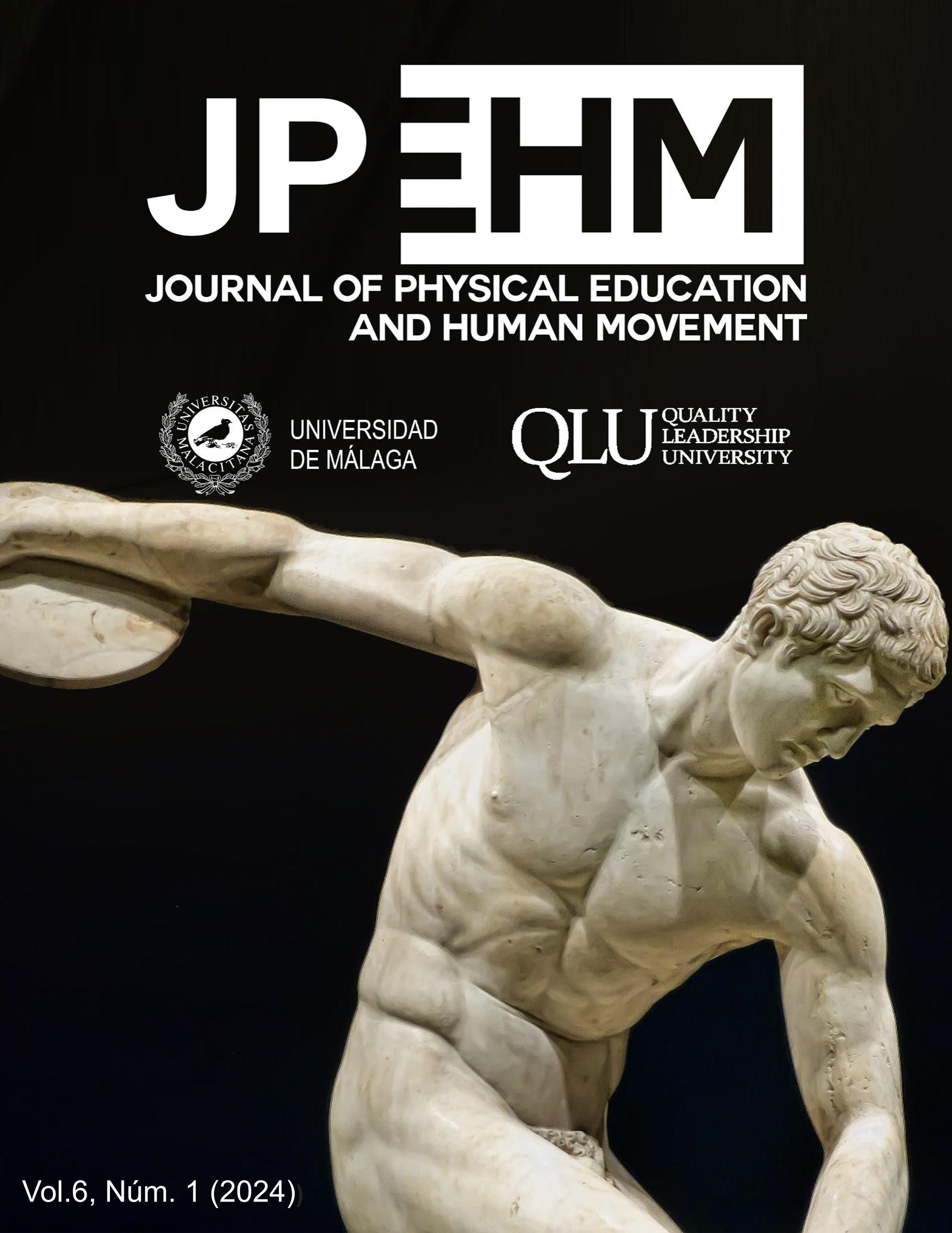La posición de la diplomacia en el deporte iraní
DOI:
https://doi.org/10.24310/jpehm.6.1.2024.17766Palabras clave:
estrategia, relaciones internacionales, gestión deportiva, IránResumen
La diplomacia deportiva es un fenómeno generalizado que a nivel diplomático es uno de los componentes más importantes de la comunicación entre países y naciones, y por ello es importante conocer cuál es la posición de Irán, como país poderoso en el campo de la diplomacia en esta área. El propósito de este estudio fue investigar la posición de la diplomacia en el deporte Iraní. El método de investigación fue descriptivo-analítico y aplicado en términos del propósito. La población estadística del estudio fueron todos los gerentes político-deportivos y expertos en el campo de la diplomacia deportiva, seleccionados mediante un muestreo intencional y accesible. El método de recolección de datos incluyó estudios de biblioteca, entrevistas semiestructuradas a expertos y finalmente el método Delphi en tres etapas. Para identificar la posición estratégica, se utilizó la Matriz de Evaluación de Factores Internos (IFE) y la Matriz de Evaluación de Factores Externos (EFE). Los resultados mostraron que la posición de la diplomacia deportiva Iraní está en la posición de WO (estrategia conservadora). En este sentido, se concluye que los funcionarios de alto nivel y los encargados de la formulación de políticas del Ministerio de Deportes, el Ministerio de Relaciones Exteriores y otras instituciones pertinentes deberían centrar sus planes en abordar las debilidades y aprovechar las oportunidades existentes.
Descargas
Métricas
Citas
Ahmadi, F., Nasiriani, Kh., Abazari, P. (2008). Delphi technique: a tool in research. Iranian Journal of Medical Education, 8 (1):175-185. https://ijme.mui.ac.ir/article-1-790-fa.pdf
Australian Government. 2017. 2017 Foreign Policy White Paper. https:// www. dfat. gov. au/ sites/ defau lt/ files/ minis ite/ static/ 4ca08 13c- 585e- 4fe1- 86eb- de665 e6500 1a/ fpwhi tepap er/ index. html.
Badeei Nameghi, S. F., Falah, Z., Behlekeh, T., & askari, A. (2023). Comparison of the problems of sports tourism tours in domestic and foreign events. Strategic Studies on Youth and Sports, 22(61), 649-662. doi: 10.22034/ssys.2022.1958.2389
Bakhshi chenari, A. R., godarzi, M., sajjadi, S. N., & Jalali Farahani, M. (2021). Identify and Prioritize the Effective Factors of Sport Diplomacy Development in Islamic Republic of Iran’s Foreign Policy. Sport Management and Development, 10(1), 130-140. doi: 10.22124/jsmd.2021.5046
Bergsgard, N,. Houlihan, B,. Mangset, P , Nodland, S., Rommetvedt, H. (2007), Sport Policy: a Comparative Analysis of Stability and Change", First Edit, Burlington: Elsevier and Book Aid International. https://scholar.sun.ac.za/server/api/core/bitstreams/307eb371-f722-4e43-85e2-8c40d0d9cb52/content
Costa, A. (2005). “The Status and Future of Sport Management: A Delphi Study”. Journal Sport Management. Human Kinetics, 16(3), 117-142. DOI: https://doi.org/10.1123/jsm.19.2.117
Eden, J,T. (2013), Soccer and International Relations: Can Soccer Improve International Relations?, Ottawa: University of Ottawa. https://ruor.uottawa.ca/server/api/core/bitstreams/89fe9319-50d6-4959-87ca-3a764726062f/content
Gachi, A., Ghafouri, F., & Kargar, G. (2023). Comparison of the Role of Macro, Mid and Micro Level Factors of Management in the Development of Championship Sport. Strategic Studies on Youth and Sports, 22(61), 277-296. doi: 10.22034/ssys.2022.1263.1874
Ghasemi, H., Farahani, A., Shakarami, Z., & Hoseini, S. S. (2013). Content analysis of sports programs with emphasis on state television coverage of women's sport. Communication Management in Sport Media, 1(2), 23-30. https://sportmedia.journals.pnu.ac.ir/article_586.html?lang=en
Khabiri, M., & Fattahi Zadeh, A. (2019). Sports Diplomacy: Acceptance and Encompassing of A Political Strategic Concept. Strategic Studies on Youth and Sports, 18(43), 143-164. https://faslname.msy.gov.ir/article_301.html
Min, D., & Choi, Y. (2018). Sport cooperation in divided Korea: an overstated role of sport diplomacy in South Korea. Sport in Society. 22. 1-15. 10.1080/17430437.2018.1536120.
Murray, S. (2012). The Two Halves of Sports-Diplomacy. Diplomacy and Statecraft, 23(3), 576-592. https://doi.org/10.1080/09592296.2012.706544
Murray, S. (2013). Sports diplomacy in the Australian context: A case study of the Department of Foreign Affairs and Trade. Sports Law eJournal, 18, 1-15. https://slej.scholasticahq.com/article/6399
Qingmin, Z. (2013). Sports diplomacy: The Chinese experience and perspective. The Hague Journal of Diplomacy 8 (2013) 211-233. https://www.sis.pku.edu.cn/teachers/docs/20190904131145743178.pdf
Republika, S., Ministerstvo, Z., Zunaje, Z.(2021). Slovenia: Safe, Successful, Globally Respected. Foreign Policy of the Republic of Slovenia, https:// www. gov. si/ assets/ minis trstva/ MZZ/ Dokum enti/ stiki-z- javno stmi/ Forei gn- Policy- Strat egy- ofthe- Repub lic- of- Slove nia. pdf. Accessed 2 Aug 2022.
Vojdani tabatabaie, I. S., mohamadian, F., & nobakht ramezani, Z. (2023). analyze political behavior in sports organizations. Strategic Studies on Youth and Sports, 22(61), 225-238. doi: 10.22034/ssys.2022.1724.2222
Woodward, R. (2020). Sport and UK Soft Power: The Case of Mount Everest. The British Journal of Politics and International Relations 22 (2): 274–292. https://doi.org/10.1177/1369148120908502
Zainulbhai, H., & Wike, R. (2015). Iran’s Global Image Mostly Negative. Washington, DC: PEW Research Center. 26(3), 153-178. https://www.pewresearch.org/,wp-content/uploads/sites/2/2015/06/Pew-Research-Center-Iran-Report-June-18-2015-FINAL.pdf
Descargas
Publicado
Cómo citar
Número
Sección
Licencia
Derechos de autor 2024 Mohammad saeid Kiani

Esta obra está bajo una licencia internacional Creative Commons Atribución-NoComercial-CompartirIgual 4.0.
Aquellos autores/as que tengan publicaciones con esta revista, aceptan los términos siguientes:
- Los autores/as conservarán sus derechos de autor y garantizarán a la revista el derecho de primera publicación de su obra, el cuál estará simultáneamente sujeto a la Licencia de reconocimiento de Creative Commons que permite a terceros compartir la obra siempre que se indique su autor y su primera publicación esta revista.
- Los autores/as podrán adoptar otros acuerdos de licencia no exclusiva de distribución de la versión de la obra publicada (p. ej.: depositarla en un archivo telemático institucional o publicarla en un volumen monográfico) siempre que se indique la publicación inicial en esta revista.
- Se permite y recomienda a los autores/as difundir su obra a través de Internet (p. ej.: en archivos telemáticos institucionales o en su página web) antes y durante el proceso de envío, lo cual puede producir intercambios interesantes y aumentar las citas de la obra publicada. (Véase El efecto del acceso abierto).







15.png)
